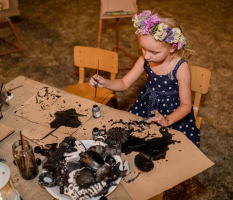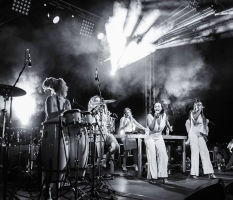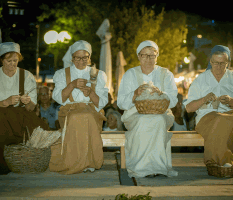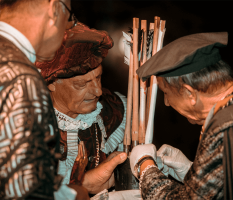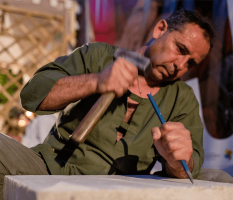- Home
- Event
- Rab Fair
Rab Fair
In the week when St Christopher's Day is celebrated, the medieval Rab Fair has been restored, respecting history and tradition.
In order to understand what this festival celebrates and how it has been transformed into today's Fjera, it is necessary to remind ourselves of the history of the city and the island. In 1358, after two years of war, the defeated Venice ceded Dalmatia to Louis I of Hungary, the Hungarian-Croatian King. After that, the people of Rab bowed to this king in Zadar and pledged allegiance to him, and he promised to grant them privileges greater than those that they had had under the Venetians. He was, therefore, celebrated as a liberator, and seven-day municipal festivities were introduced in his honour. On 21 July 1364, in tribute to Louis I of Hungary and to the sacred memory and honour of St Christopher, the Grand Council of the City of Rab adopted a special decree whereby the following dates were to be celebrated: 9 May, Dies Victoriae (Victory Day), when Rab was freed from the Norman rule in 1075 due to the intercession of St Christopher, and 27 July, Dies Natalis, the day when St Christopher, the patron saint of Rab, died a martyr's death. The latter is celebrated by the Church as his birthday – the day he was born for heaven.
During municipal public festivities called tempus feriarum, the court in the city was closed and the city gates were open to everyone, so debtors from the countryside were free to enter and leave Rab in the fifteen-day period, when meting out justice or persecuting debtors was not allowed. Those festivities, with minor interruptions, took place from 1364 to 1852, when they were abolished by the Bishop of Krk because people’s behaviour got out of hand. But people still came to the city for the feasts of St James on 25 July, St Anne on 26 July and St Christopher on 27 July. These festivities were more like a fair, which the population of the city called fjera (Italian fiera). The custom lasted until the 1950s, when it disappeared. The festivities were restored in 2002 as a folklore event. It was officially named the Rab Fair the following year, and has been called by this name ever since.
How important the Fair is for the preservation of the cultural heritage and tradition of the island of Rab is best illustrated by a passage from the foreword to the 2006 Rab Fair catalogue, written by the academician Slobodan Novak on the Fair’s fifth anniversary. In it he says: "Even before it was restored, the Rab Fair was not, and it is especially not today – just an attractive spectacle (...) It is, on the contrary, a dignified ceremony, just as it was when it was inaugurated six and a half centuries ago. And it is not just an empty bright parade, but indeed an expression of the desire to penetrate, even if only by intuition, the darkness of centuries gone by where the shadows of our ancestors are still recognisable; to look at one's own roots, to confirm and reinforce one's identity. To recall, connected and liberated/restrained by sophisticated modern technologies, the beauty of working with one’s hands and the skill of fingers, calluses instead of gloves, the predestined bond with nature, with the soil and the sea; the spiritual and material creations of our ancestors, their individual singular creativity, which is rather forgotten in the time of teamwork, conveyor belts and ready-made garments."
The restored festivities are celebrated for three days, with the opening on 25 July, the feast of St James, continuing on 26 July, the feast of St Anne, and ending at midnight on 27 July, the feast of St Christopher.
The opening ceremony of the Rab Fair is a magnificent spectacle. The event begins with a gathering of all costumed participants in Gornja Street in Rab, who then descend the Bobotina steps in procession to reach St Christopher's Square, or Varoš, as it was called in mediaeval times – a truly magnificent scene. In his role as Count and standing in front of thousands of visitors, the mayor of the City of Rab declares the Rab Fair open by medieval decree, whereby the gates of the city are opened to all, and great rejoicing can begin. Then the ceremonial procession, led by the Herald and the Crossbowmen of Rab and consisting of the Count accompanied by the city's nobility and aristocracy, the guests of honour and visitors from twin towns, Rab artisans, craftsmen, merchants, artists, entertainers, jugglers and others, heads down Srednja Street towards the Town Loggia, where everyone is entered in the Rab Fair book. The nobility then continues their dignified tour of the medieval town, and other participants start their work by the light of torches in workshops spread across the squares, streets and courtyards of the oldest part of the city – Kaldanac. In addition to around sixty workshops of the Rab inhabitants, most of who pursue the crafts they present in these workshops as their professions in contemporary, real, life (bakers, honey makers, stonemasons, carpenters, silk painters, boatbuilders, shellfishermen, sponge divers, basket weavers, ropemakers, painters, florists, trap-net makers, potters, lacemakers, spinners, cheesemakers, heraldists, Glagolitic script craftsmen and many others), the festival also includes the largest associations on the island of Rab (Komin, Dolin, Škraparica and Tunera), the Association of Rab Crossbowmen, the Rapski Tanac Folk Ensemble, Rab a cappella vocal ensembles (called klape) Sozal, Euphemia, Kristofor and Rab, knights from Königsbrunn, falconers from Šibenik, the Požega artillerists, as well as a dozen workshops by our friends from San Marino, i.e. their Arti e Mestieri association from the castello (municipality) of Montegiardino.
Trg Slobode (Freedom Square), formerly Pjaceta market, is the main trading venue. Here, visitors can taste local wine, fruit brandy (called rakija), dried figs, salted fish. A pleasant scent of native herbs and flowers spreads from the stands. There is a florist knitting garlands of hydrangeas, and, next to her, a coinsmith can be heard striking the anvil. Potters diligently spin their wheels, where clay turns into the simple forms of medieval dishes. The bakers fry frite (fried dough fritters) and offer a multi-award winning and world-famous culinary delight – the Rab Cake – and other traditional desserts; a little further, lacemakers quietly make their needlework, and next to them there are the cheerful voices of the youngest participants in the festivities – the children of the Pahuljica (Snowflake) Nursery School. On the other side is the tanner; next to him are the musicians, and a little further down the courtyard is the stonemason.
The seafront promenade below Pjaceta offers a special and unique experience. The tempting scents of homemade dishes spread from the picturesque heritage village, where several rural families reside, and Rab shepherds make cheese and wool. Looking at the sea and fishermen light fishing, or frying fish and offering salted fish, and the boatmaker working on his boat brings out the deep feelings of the local population towards fishing and the fishing profession.
Moving away from Pjaceta towards the Cathedral, you will come across a medieval household. Olives and grapes are stomped on in front of the entrance and oil and wine are made in the original medieval way; while inside, under the low ceiling, everything is busy and hot: the women comb wool, the cobbler repairs shoes, grain is ground into flour, bread is baked under the bell, the hosts offer prosciutto, wine, brandy and fresh eggs of chickens kept in the back garden. The crowd is entertained by the hosts’ a cappella singing and folk dancing.
Further along the way to the Cathedral, Glagolitic script craftsmen use the Glagolitic alphabet to write the visitors’ names or greetings to their friends from holidays; young girls offer medicinal drinks; and the cheerful crowd walking down this path is entertained by the performances of street musicians, singers, dancers and jugglers, as well as by the terrible appearances of executioners and lepers, and the grace of noblemen and noblewomen.
In front of the Cathedral, painters’ creative energy can be felt, and the sellers of religious souvenirs gracefully endure the noise coming from the nearby winemaker’s and the bocce ball court.
On the way to Kaldanac and down Bishop Drago Street, women from San Marino bake flatbread; near them there is a seller of medicinal herbs, and silk painters and antiquarians are situated further down the street. At the very end, already in Municipium Arba Square, there is the last workshop – the medieval post office.
In addition to this special outdoor experience, seven restaurants in the old town offer medieval dishes and drinks to visitors in the days of the Fair, and the service and clothing reflect the spirit of the Middle Ages.
On St Christopher's Day, 27 July, the Knights of Rab have a crossbow competition and parade through the city to the sound of drums and fanfare, and the winner is rewarded.
Namely, on 21 July 1364, the date already mentioned, the Grand Council of the City of Rab introduced a crossbow competition of noblemen and commoners – the Rab Tournament. There are not many historical records of tournaments held on the island of Rab in the 14th century. It was written down that the decision on the first tournament (exercises) was made by the City Council, but there is no confirmation that the tournament was held continuously and no mention of its rules. It is known that noblemen and commoners both competed and that the best crossbowman received a prize of 100 light librae. Before the tournament, a chest with the relics of St Christopher was carried in procession through the city, after which archers had a competition in shooting from a medieval ballista.
The renewed medieval tournament taking place during the Rab Fair begins with a gathering of crossbowmen, trumpet players and standard bearers, as well as noblemen and noblewomen wearing medieval clothes (the count and countess, his notary, the vice-count, the judges, the treasurer, the herald, the advisers and other nobility). To the sound of trumpets and loud drumming, the procession heads towards the Cathedral. There they are greeted and blessed by the pro-vicar of the parish church of the Assumption of Mary, who wishes luck to the contestants. From the Cathedral, the participants continue to Varoš. On the throne there sits the count of Rab, next to him is the vice-count, the notary public, the three members of the court of honour, and other members of the nobility. The tournament begins when the court sets the rules and the count gives his permission to start. When the competition is over, the colourful procession heads towards Count’s Palace, where the Rab Tournament ends with the lowering of the Fair flag and the strike of the cannon, followed by fireworks at the stroke of midnight. The fireworks symbolically mark the return to the present, ending the three-day Rab Fair festivities.








